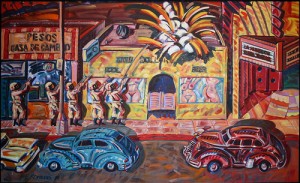Ruben Salazar: His Life And Work Remembered
 The painting in the picture depicts the moment that Los Angeles journalist Ruben Salazar was killed 41 years ago.
The painting in the picture depicts the moment that Los Angeles journalist Ruben Salazar was killed 41 years ago.
For many years the cause of Salazar’s death was a matter of controversy and cover up. He was as seasoned a journalist as journalists get: a TV news director, newspaper columnist, Vietnam correspondent. He was covering the National Chicano Moratorium March against the Vietnam War on August 29, 1970, when he was killed, shot at close range at the hands of an LA County Sheriff’s Deputy as he sat at the Silver Dollar Cafe. He was one of the main figures of the Chicano movement of the 1960’s.
The art in the picture was done by Frank Romero, in 1986. I like the piece, maybe that’s why I included it. But also, I don’t own a picture of Ruben and there are no unlicensed photos of him available for republshing. The U.S. Postal Service issued a stamp with his likeness on it in 2008, you can see it here if you’d like, but I prefer the painting, at least for now, because it makes us remember the violence of that day, at that moment.
Ruben was the first main stream media reporter to cover the Latino, Chicano community in depth. As news director at Univisión’s KMEX he investigted allegations that police officers had planted evidence against Chicanos in the police shooting of two Mexican nationals. In March of 1970 he aired footage of a police beating of two Chicano students. Many, to this, day, believe those investigations cost him his life.
Six months before he died Salazar wrote in the LA Times, as an answer to the question “Who is a Chicano?”
A Chicano is a Mexican-American with a non-Anglo image of himself.
About three years ago the LA Times published an online story that included several of his columns. It seemed to me the best way to remember Salazar and his work was not recount it, but to make it available. So here’s a link to that LA Times piece. Give it a read; remember him today.
Follow Victor Landa on Twitter: @vlanda
[Image by cliff1066™]
